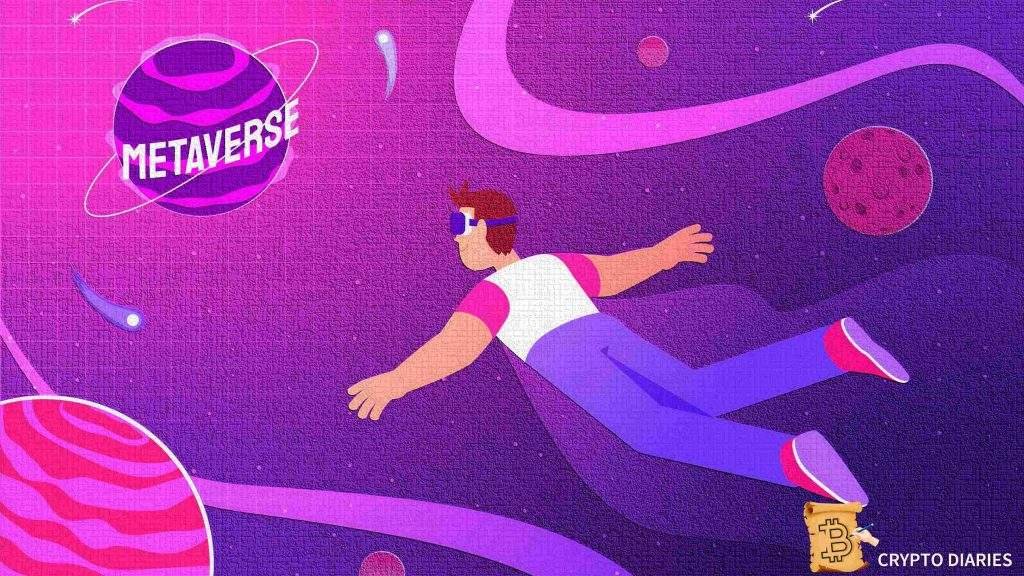The term ‘metaverse’ has become one of the most popular catchphrases of the past year, largely thanks to Facebook’s declaration that it was changing its name to Meta and investing heavily in metaverse capabilities.
The Metawhat?
Consider a digital environment in which people may live, work, shop, and engage with others from the coziness of their sofa in the real world. This is what we call the Metaverse.
There is a belief that the metaverse will lead the internet’s future development. Folks will cooperate using a virtual facsimile or avatar of themselves during corporate meetings, online communities, and gaming, among other contexts.
The metaverse is a three-dimensional immersive digital world in which individuals can engage and create in-world experiences, places, landscapes, and items. These digital worlds allow users to purchase and sell goods much like in the real world since they have their economies and currencies.
People can work, socialize, play, and shop in metaverses because they replicate the real world. Additionally, they provide users with a sense of presence in the simulated environment and a sense that others are also there.
The idea of the metaverse is not new. The 1992 book Snow Crash is where it was initially born. Later, several businesses created online communities founded on the notion, most significantly Second Life, which Neal Stephenson introduced in 2003.
In his book Snow Crash, Stephenson describes this technology. However, the concept has now advanced in tandem with the development of blockchain technology, which supports autonomy. Blockchain technology will be a fundamental tenet of the virtual world to protect privacy, speed up transactions, and improve consensus during decision-making processes.
Better Than Web 2.0 Technology
According to Meta, the metaverse will enhance individuals’ engagement in everyday activities like communication, business, and other services. Given the companies and movements created by Web 2.0, it will eliminate the necessity for in-person gatherings to complete tasks.
Online stores, social networks, game rooms, and streaming services were all incorporated by the Web 2.0 interface. In a virtual environment that is more realistic than web 2.0, the virtual world will let individuals communicate with their loved ones, locate their beloved outfits, and form groups in that other person who shares their views can participate.
The metaverse, which people believe to be the internet’s replacement, consists of interactive places where users share and can collaborate, invent, and connect with others even when they are not in the exact physical location. They create 3D avatars to accomplish this.
It combines actual and virtual lifestyles in the same online realm using augmented reality concepts.
How The Metaverse And Web 3.0 Relate
Contrary to popular belief, the Metaverse is not the same as Web3, the third generation of the World Wide Web. Users can communicate with virtual objects and others in a 3D environment in the parallel digital world known as the Metaverse. It is the development of the web into a three-dimensional virtual setting. Users can create avatars on this realistic, dynamic, and social platform to portray themselves. They can also buy and trade virtual products and interact in real-time with other people.
How They Differ
The critical difference between the two systems is that users of Web3 engage the Metaverse in a manner akin to how a vehicle uses a road.
Web3 will allow for decentralized management and ownership of the web by users and the public. On the other hand, the virtual world is a shared virtual environment that enables people to connect in real-time, build economies, and communicate with one another regardless of possession.
While Web3 has blockchain technology and cryptocurrencies as its basis, the metaverse uses AR/VR and virtual currency. This is due to the distributed nature of Web3 and the absence of massive business control or involvement.
Additionally, the two are put to different uses—a new set of rules known as Web3 outlines how the web should be used and governed. The metaverse includes social media, online gaming, retail, and other activities.
The Metaverse has several essential technologies that enable the smooth running of the entire ecosystem. The Metaverse must be built via connections, interfaces, decentralization, a creative economy, and cutting-edge technologies. However, Web 3.0 aims to create a decentralized web that only employs distributed ledger technology. Users can interact with internet platforms using blockchain, a decentralized peer-to-peer framework that manages it.
Their Similarities
Aside from these distinctions, there are other similarities between the two, including the following:
Web3 and the metaverse are tightly linked. The metaverse will maintain its existence in surface and deep webs even if Web3 is still generally alluded to as being decentralized; nevertheless, the virtual world will stay centralized regarding social media controlling networks.
Both run utilizing cutting-edge, future-proof technology. The metaverse and Web3.0 are connected through the semantic web. Another critical component of both technologies is AI, which will significantly create a complicated user experience.
The two technologies are becoming more compatible because of the advancements in technology made with blockchain. Each new blockchain concept is evaluated as a possible module utilizing the Web3.0 engine to power the services and products of the metaverse.
The metaverse and Web3 are both in their early stages. The final products might be entirely different in a few years because software isn’t always put to its envisioned use.
How Will Someone Be Able To Access The Metaverse?
There will be numerous dimensions in the virtual world beyond the ones already mentioned by Meta and the gaming industry. For instance, crypto fanatics will have their plots to use, equipped with cryptocurrency tools.
Participants must register accounts, develop personas, and experience the virtual world’s infinite possibilities before engaging in in-room interactions.
The interface between the offline and digital worlds will be unique glasses or virtual reality headsets. A strange scenario depicted is a well-known artist spending some art practices with devoted fans.
All of this capability, however, carries a risk because it serves as a haven for crooks. For example, it will be simple for a terrorist to enter a room, spread hate, issue threats, and convey coercive messaging. Although the internet is rife with these flaws, users haven’t let that prevent them from surfing.
All The Gear You Need For Access
Different tools are required to access the virtual world depending on the network one wishes to access. For instance, Meta needs users to buy Oculus Quest 2VR headsets to access their metaverse. Even though they don’t need additional hardware like a PC or gaming console, these headsets will cost a user roughly $300.
Unlike Meta, other VR headset manufacturers like HTC, SONY, HP, and Valve link to PCs or PlayStation 4 and 5. There are also different sorts, some of which might even permit a link to a cell phone. One business attempting to create AR glasses that work with a smartphone is Qualcomm.
Certain metaverses demand the use of all of the mentioned technology, while others don’t. The critical distinction is that AR/VR headsets provide a 360-degree perspective of the virtual world compared to those used with PCs and consoles alone. Folks may visit Roblox and Minecraft from their equipment without wearing AR or VR headsets because they are such metaverses.
NFTs In The Metaverse
NFTs, or non-fungible tokens, are distinct and can’t be exchanged for other assets. They support the development of the metaverse as a digital resource. They stand in for immaterial objects like virtual attributes, graphics, or trinkets found in games. NFT possession is tracked on the blockchain, and one can exchange it for virtual assets.
NFTs are expected to impact the utility and acceptance of the metaverse significantly. NFTs are a safe class of virtual currency built on the same blockchain technology as cryptocurrencies. An NFT can stand in for something other than money, such as a work of art, a song, or digital property. An NFT provides the owner with a type of electronic deed or evidence of possession that is tradeable in the metaverse.
Companies That Used This Opportunity
Metaverse Properties claims to be the world’s first digital real estate firm. In various metaverse digital environments, the business serves as an agent to make buying or renting real estate easier.
Existing brick-and-mortar businesses are also entering the metaverse market, even though it has provided an opportunity for new companies like Metaverse Properties to sell digital items. For instance, Nike recently bought RTFKT, a firm that uses NFTs, blockchain verification, and augmented reality to create unique virtual footwear and digital relics. The company RTFKT claimed on its website that it was ‘founded on the metaverse,’ which has characterized its vibe to this day.
Nike submitted seven trademark applications before the takeover to assist design and selling of digital sneakers and clothing. Additionally, Nike and Roblox collaborated on ‘Nikeland,’ a simulated environment where Nike enthusiasts can enjoy playing games, interacting, and outfitting their avatars in clothing.
NFTs are accessible in the conventional metaverse in addition to NFT metaverses. NFTs are tokens that some gaming metaverses use to pay their players in P2E systems. Some even have galleries where customers may purchase artwork using NFTs from online galleries. These developments demonstrate the synergistic relationship between the metaverse and NFTs as two technological innovations.
Final Thoughts
According to certain greats like Elon Musk, the metaverse may take several years to reach its full potential, who claim it is yet too early to predict what it will undoubtedly deliver.
Although the concept of participating in an online virtual world has been for a while, a true metaverse where real-world interactions are feasible is still years away. Most people lack the VR goggles and motion capture gloves needed to precisely catch their expressions, body language, and voice quality remarked Microsoft co-founder Bill Gates in his yearly year-in-review blog post.
Mr. Gates appears to have been correct, as the UAE Ministry of Economy announced the debut of its new address, which can be ‘visited’ from anywhere on the planet because it is usually within the digital reality. The proclamation was made recently at the Museum of the Future during a conference on the opening day of the Dubai Metaverse Assembly by Abdulla bin Touq Al Marri, UAE Minister of Economy.
A metaverse is a realistic option for many issues in the physical world, at least from the perspective of logic. Additionally, it provides several opportunities to enhance interactions between people and implement decentralization in every area of human contact.
An entrepreneur might quickly gain wealth if they can successfully merge the metaverse, the cryptocurrency sector, and Web 3 in a commercial setting. The breakthroughs are under scrutiny for 2022 and beyond, but nothing about them is assured.

